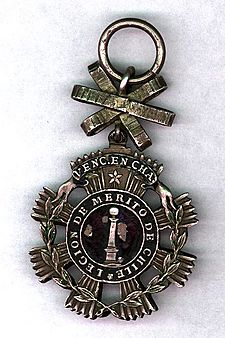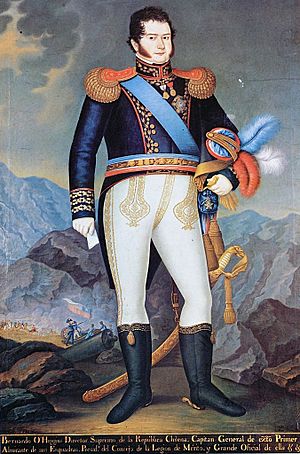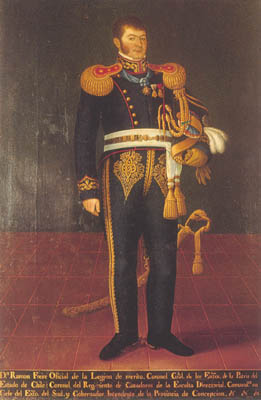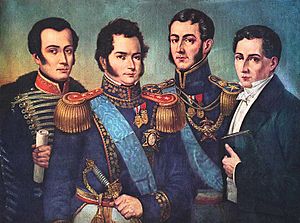Legion of Merit of Chile facts for kids
Quick facts for kids Legion of Merit(Legion de Mérito de Chile) |
|
|---|---|

Obverse of the Type I breast badge of the Legion of Merit of Chile, IV Class. Shown is the design used for those who fought at the Battle of Chacabuco, June 1817. This specimen is missing its enamel work.
|
|
| Awarded by Republic of Chile | |
| Type | Order of merit |
| Motto | Libertad |
| Eligibility | Chilean citizens and foreign supporters of Chile |
| Awarded for | Distinguished personal merit contributing to the independence of Chile or to the nation |
| Status | Abolished in 1825 |
| President of the institution | Supreme Director of Chile |
| Grades | I: Grand Officers II: Officers III: Sub-officers IV: Legionnaires |
The Legion of Merit of Chile (Spanish: Legion de Mérito de Chile) was a special award created in Chile. It was like an honor society. Bernardo O'Higgins started it on June 1, 1817.
The award was given to people who did great things for Chile's independence or for the country itself. Being a member of the Legion gave people special rights and honors in Chile. Members wore special badges and ribbons to show their rank. The Legion of Merit of Chile was stopped in 1825.
Contents
What Was the Legion of Merit?
The Legion of Merit of Chile was set up like the French Légion d'honneur, which is another famous honor. The leader of Chile at the time, called the Supreme Director of Chile, was also the head of the Legion.
The Legion had four different levels or classes:
- Grand Officers of the Legion (Spanish: Grandes Oficiales de la Legion), Class I: This was for very high-ranking military leaders, like generals.
- Officers of the Legion (Spanish: Oficiales de la Legion), Class II: This level was for colonels and similar ranks.
- Sub-officers of the Legion (Spanish: Sub-oficiales de la Legion), Class III: This was for people like sergeants major (similar to today's majors).
- Legionnaires or Members of the Legion (Spanish: Legionarios ó Miembros de la Legion), Class IV: This level was for lieutenants and similar ranks.
Everyone who joined the Legion had to promise to defend Chile. They also promised to protect its freedom and independence. They had to remember the important duty and honor they received.
The Legion's Council
There was a group called the Council of the Legion (Spanish: El Consejo de la Legion). The Supreme Director was in charge of this council. It also included Grand Officers, Officers, Sub-officers, and Legionnaires.
The council had important jobs. They made sure the Legion's rules were followed. They also approved new members. If a member did something dishonorable, the council could take away their award. They also managed the Legion's money and pensions for its members.
History of the Legion
How It Started
The Legion of Merit was created by Bernardo O'Higgins on June 1, 1817. He was the Supreme Director of Chile, which had just become independent. He started it after important battles like Chacabuco and Maipú. The award was meant to honor people who helped free Chile or served the nation. At that time, it was the highest honor in Chile.
O'Higgins was the son of Ambrosio O'Higgins, a Spanish officer from Ireland. His mother was Isabel Riquelme. Bernardo O'Higgins wanted to create a new way to recognize people's achievements. He had removed the old system of nobility in Chile. The Legion of Merit was a new system that was more equal. This idea was popular with many revolutionaries. However, it upset some of the older, powerful families.
The first people to receive the award were those who fought at the Battle of Chacabuco. This included Bernardo O'Higgins himself. It also included José de San Martín, a leader from Argentina, and other top generals. Officers and soldiers who showed great bravery in the battle were also chosen.
Later, new members could be chosen by the Council of the Legion. These people had to show "distinguished personal merit." This meant the award wasn't just for military heroes. It could also go to religious leaders, judges, government workers, artists, or anyone else who did something truly special for Chile.
Special Rights for Members
Being a member of the Legion came with several special rights. Members received a yearly payment called a pension. This money came from the lands taken from Spanish supporters who had left Chile during the Chilean War of Independence.
- Grand Officers received 1000 pesos each year.
- Officers received 500 pesos.
- Sub-officers received 250 pesos.
- Legionnaires received 150 pesos.
If a Legion member was accused of a crime, they had the right to a special trial. This trial would be held by a private court made up of other Legion members. If they were found guilty by a regular court, the Legion's court could review the decision. They could even change or cancel the verdict.
Military members of the Legion had more freedom in their barracks. Other people were not allowed to insult or bother Legion members. When traveling, members could stay overnight at any ranch. They would be given food and a place to sleep for themselves and their companions.
Special rules were made for citizens of other countries, like Argentina. This was to make sure the Legion's rules didn't conflict with their own citizenship. For example, their oath was different, and their right to a Legion trial was limited to crimes committed in Chile.
End of the Legion
In 1823, the Chilean Senate tried to get rid of the Legion. They said there wasn't enough money to pay the pensions. O'Higgins did not agree with this decision. However, after O'Higgins left his position in January 1823, the Senate cut off the Legion's money. They only allowed 3000 pesos a year to start a naval school.
The old, powerful families in Santiago were worried. They thought the Legion was becoming a new type of nobility. They saw it as a threat to their own status. Finally, in June 1825, the leader of the government, José Miguel Infante, stopped all funding. He also officially ended the Legion. No new members were appointed after that. However, pictures from later times show that existing members still wore their Legion badges.
Legion Insignia
Like other awards of its time, the Legion of Merit used different badges and symbols. These showed the rank of the person who received the award.
The Badge of the Legion
Front Side. The badge was a five-pointed star pointing upwards. It had a small loop at the top for a ribbon. Each point of the star had a small ball on the end. In the middle of the star was a round disc. This disc had a circle around the edge with the words LEGION DE MERITO DE CHILE. The center of the disc was sky blue. It showed a column with a globe on top, resting on the ground. This design came from the Chilean coat of arms at the time.
The star rested on a green laurel wreath. At the top of the wreath was a small scroll. For those who fought at the Battle of Chacabuco, the scroll said VENC EN CHA (meaning "Victor of Chacabuco"). For others, it said LIBERTAD (meaning "Liberty"). Under the star and wreath, there were silver rays for Legionnaires and gold rays for higher classes.
Back Side. The back of the badge looked similar to the front. The circle on the back said HONOR Y PREMIO AL PATRIOTISMO (meaning "Honour and Award for Patriotism"). The scroll said O'HIG S INST. The center of the disc showed a volcano erupting in a mountain range.
Some badges for lower classes did not have the five-point star. Higher class badges used different materials like enamel, silver, gold, and even jewels for the highest class. Sometimes, the text on the front and back scrolls was swapped.
How to Wear the Insignia
Members of the Legion were encouraged to wear their badges with all types of clothing. If they didn't want to wear the full badge, they could wear a sky blue ribbon. This ribbon would go through a buttonhole on their coat. It would be attached to a small pin, either silver for Legionnaires or gold for the other classes.
- Grand Officers. When in their formal uniform, Grand Officers wore a gold star on their left side. They also wore a sky blue sash over their right shoulder. The badge of the Legion hung from this sash on their left hip. When not in formal uniform, they could wear the badge from a buttonhole with a sky blue rosette.
- Officers. In formal uniform, Officers wore the gold badge around their neck. It hung from a wide sky blue ribbon. When not in formal uniform, they could wear the badge from a buttonhole with a sky blue rosette.
- Sub-officers. Sub-officers wore the gold badge from a buttonhole on their coat. It hung from a sky blue ribbon.
- Legionnaires. Legionnaires wore the silver badge from a buttonhole on their coat. It also hung from a sky blue ribbon.
Famous Members
Grand Officers
- Bernardo O'Higgins: Appointed a Grand Officer in 1817.
- Ramón Freire: Started as an Officer and later became a Grand Officer.
- José de San Martín: Appointed a Grand Officer in 1817.
Officers
- Rudecindo Alvarado
- Antonio Beruti
- Tomás Guido: Started as a Sub-officer in 1820 and became an Officer in 1822.
- Juan Gregorio de las Heras
- Mariano Necochea
- José Matía Zapiola
- José Ignacio Zenteno
Sub-officers
Legionnaires
- José Antonio Rodríguez Aldea: Appointed a Legionnaire in 1821.
- Giuseppe Rondizzoni
See also
 In Spanish: Legión de Mérito de Chile para niños
In Spanish: Legión de Mérito de Chile para niños
- Orders, decorations, and medals of Chile
- Order of Merit (Chile)




